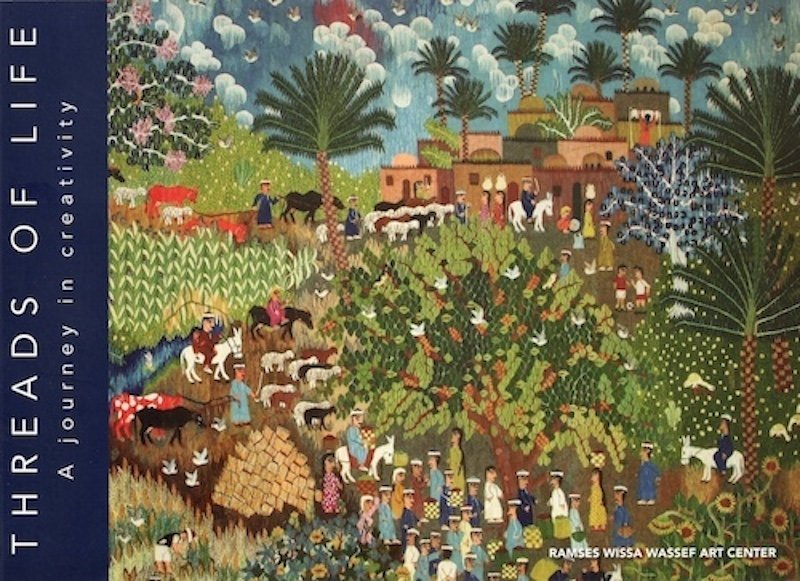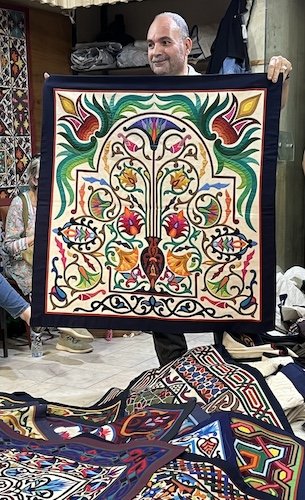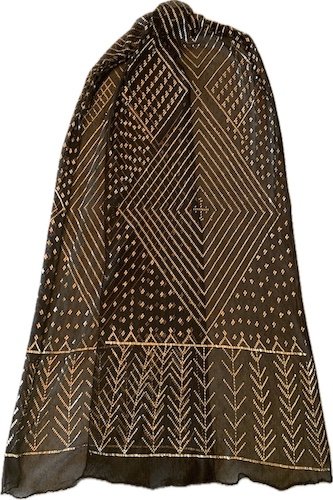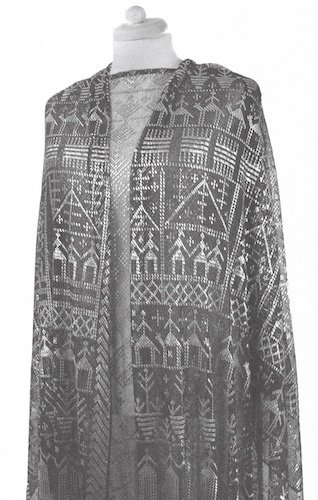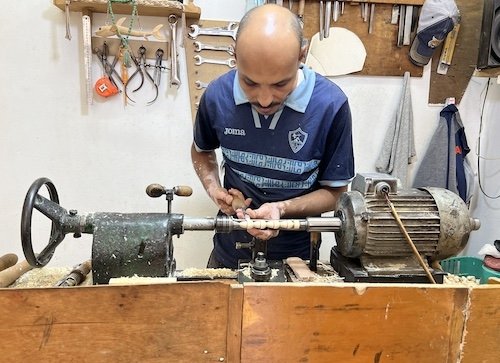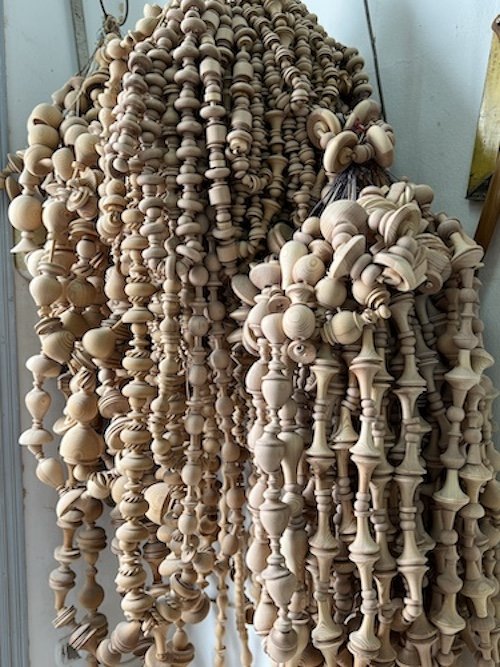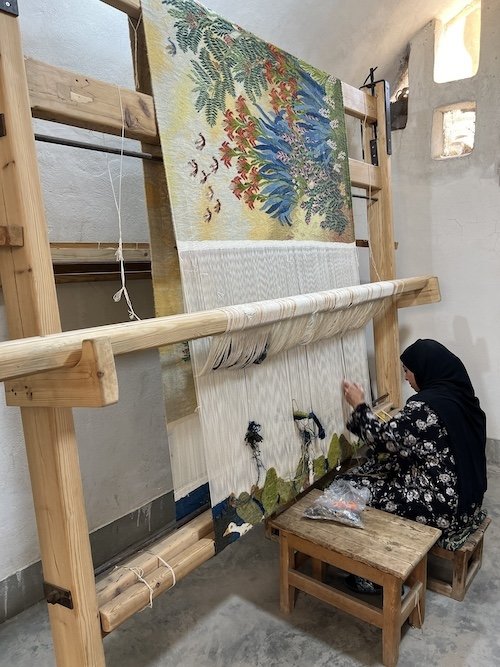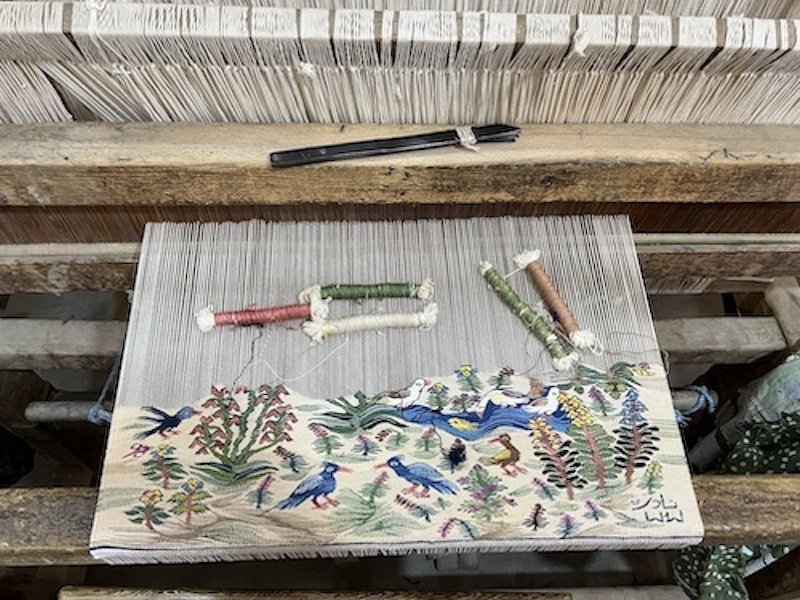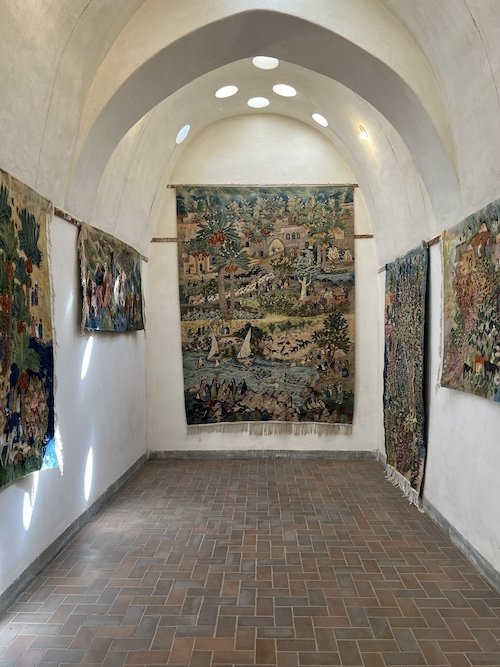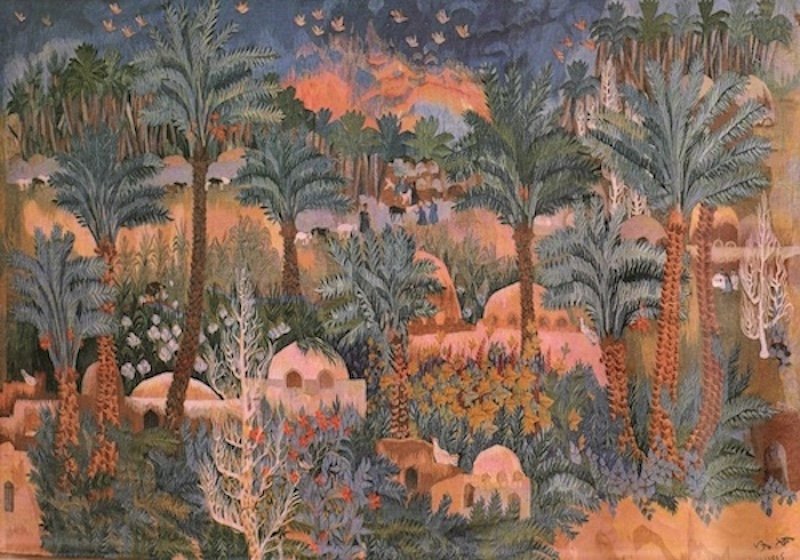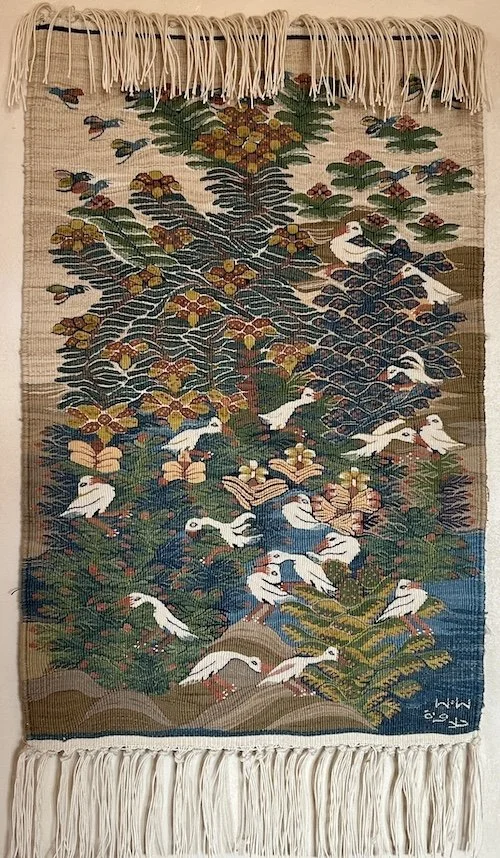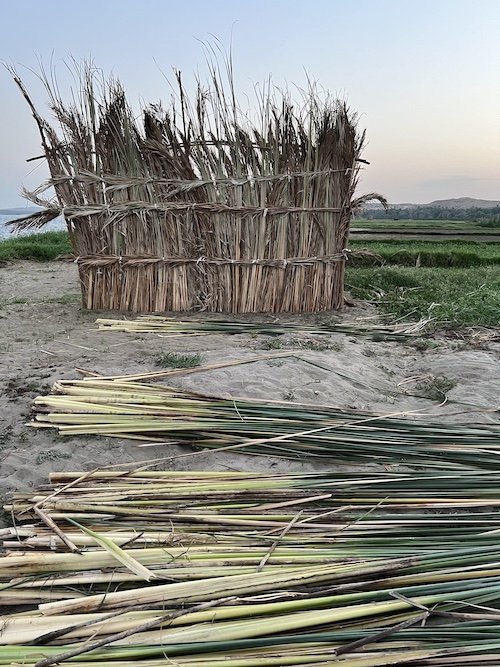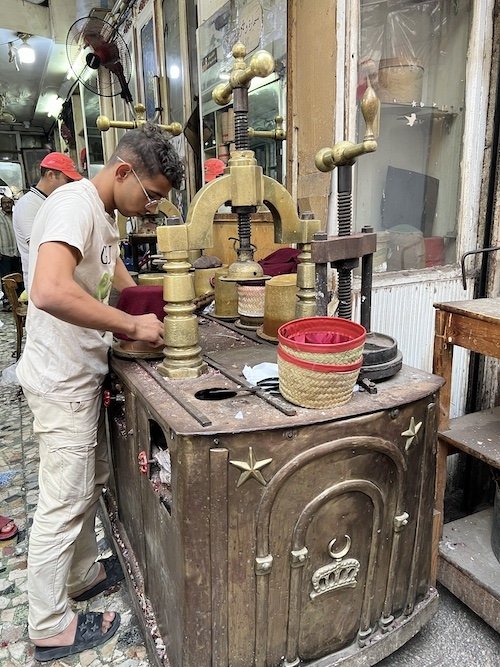Exploring Egypt - Textiles Today
In my last blog post I shared our experiences on a recent tour of the Nile Valley of the textiles from ancient Egypt as brought to life by the stories told to us by Nancy Arthur Hoskins. On this tour we also visited several contemporary practitioners of textile arts that are being kept alive today, and these were as wonderful to see as the ancient sites.
The Tentmakers of Cairo - During the time that I spent in Egypt in the late 1970’s I saw lots of examples of appliqued and embroidered textiles depicting scenes of ancient and contemporary Egyptian life created in brightly colored cloth. I didn’t bring any of these pieces home with me from that trip, but my mother and sisters had some of them decorating the walls of their homes.
About half a dozen years ago a group representing the Tentmakers of Cairo began showing at the International Folk Art Market in Santa Fe. I was pleased to see that not only was this traditional art form surviving, but was blossoming in both technical skills and artistic sophistication. In preparation for our tour I started doing some research into this traditional art form and learning about its history.
A book titled The Tentmakers of Cairo presented an in-depth background on the long history of decorated tents being used both for nomadic purposes and for celebratory occasions such as weddings. It also had extensive interviews with several of the artisans who are still working in this medium today. I also found that a documentary film about the Tentmakers had been made about ten years ago and I was able to download and watch this film, which not only showed the process of making these textiles, but gave direct insight into what was going on the country shortly after the Arab Spring took place.
In the ancient and fascinating open-air bazaar of Khan-el-Khalili there is a street called El Khayamiya, which means Street of Tentmakers. Up until a few decades ago there were close to a hundred stalls where men who created these textiles displayed and sold their work. Today there are only about seven or eight of these stalls and most of the work is smaller in scale to suit the tourist market, though the workmanship and designs are perhaps the best they have ever been.
Left - El Khayamiya 1902 Right - A stall in El Khayamiya today
Our group wandered through the labyrinth of Khan-el-Khalili and ultimately visited one of these stalls and we were invited upstairs to their private showroom. Our host demonstrated the process of making one of these textiles, beginning with transferring a design from a large design that was drawn on canvas and pierced with holes to another piece of canvas that is used as the substrate for sewing on the colored fabrics. Then scraps of fabrics are pulled from a pile and sewn piece by piece onto the canvas backing. Decisions about what colors to use are made in the moment and huge scissors are used to cut the fabric pieces into shape as the sewing progresses - nothing is drawn onto the colored fabric before the sewing begins
After we watched in amazement how spontaneous the sewing process was and yet yielded such precise results, we were treated to stacks of finished pieces being brought in and displayed for us one at a time. I think that nearly everyone in our group went home with something, whether a small pillow cover or a larger work of art.
Tally Assuit Women’s Collective - I first learned about a type of textile that can go by a variety of names - Assuit, Assiut, Assyut, its offical name Tulle-bi-telli, or more commonly simply Tally, when I saw belly dancers wearing tunics made of this stunning fabric in the 1990’s. At the time I was told that this type of textile stopped being made during the 1940’s and that vintage pieces were highly prized. Several years later I was unexpectedly gifted a gorgeous vintage Tally shawl in mint condition.
A couple years ago during the International Folk Art Market in Santa Fe I came upon a group called the Tally Assuit Womens Collective that has been creating these textiles since the late1990’s, supported in large part by a grant from UNESCO. While now using an alloy thread that doesn’t tarnish instead of the original silver, these contemporary textiles are still using traditional motifs. I was able to find one book about these textiles on the internet and to get a special order of one that is now out of print through the representative at the Folk Art Market.
I contacted Traysi, who organizes the collective from her apartment in the Giza neighborhood outside Cairo and works with women who create the textiles from their homes in villages in the region of Sohag. She invited me to visit her at her apartment and to bring along three of the other women that I traveled with.
Starting with a base of a commercial cotton netted fabric, thin strips of metal are embroidered into the netting using a special needle with two holes.
Traysi told us that it had taken her six month to master the single embroidery stitch that is composed of six steps. She gave us a small swatch of the netted fabric and let us try it for ourselves with her guidance. After trying it myself with Traysi’s help I could appreciate the practice and focus that it would take to perfect the stitch.
Traditional motifs with symbolic meanings, as well as geometric designs, are stitched into the netting in horizontal rows. The textiles were traditionally used for wedding shawls and other special occasions.
I haven’t been able to find a definitive answer as to when these textiles were first made. In the resources I have found there are references made to textiles embroidered with metal threads going back many hundreds of years, but this particular technique may go back just as far as the 18th or 19th centuries AD. Toward the end of our tour we visited the new Alexandria library, which has many collections and exhibits of art in addition to its millions of books. In one display there was a beautiful vintage robe, though there was no date attached.
After we practiced the Tally stitch Traysi brought out racks of scarves, tunics, and jackets made of the fabric, and also had shelves of smaller items such as small pouches and purses that were for sale. By this time the sun was setting over the Pyramids, and we went back to our hotel with not only special pieces of Tally fabric, but with memories of a very special experience.
Sevinche Passementerie - A somewhat unexpected artform to find on the outskirts of Cairo is high-end passementerie for fancy hotels and palaces. Our lovely hosts, Sevinch and Michael, are originally from France, but moved to Egypt about 30 years ago when Michael started a job there. Sevinch is the creative genius behind this enterprise, and once Michael retired he joined in with running the business.
I first heard about Sevinch Passementerie when Sheila O’Hara was asked to go to Egypt to help them set up an AVL jacquard loom that they had custom ordered. You can read an article about the experiences that Sheila and her husband Bill had during their weeks in Egypt in 2006 on Sheila’s website, sheilaohara.com. Because of Sheila’s connection with Sevinch, Nancy Arthur Hoskins has been able to arrange private tours to their workshop on all of her trips.
From the moment we walked into the front courtyard we were treated to a visual cornucopia of fantastical colors and shapes - and they are everywhere you look.
Sevinch herself imagines all of these creations, either straight out of her imagination or to fit in with the decoration scheme for a special client. I felt like these might be what you would find if Dr. Seuss had been turned loose with an unlimited supply of fabulous fibers.
The actual logistics of making these wonderful things goes to her staff of about 30 employees, each of whom has his own particular specialty. We began with the dye master. With just about ten jars of pigment powder and some pots, he is able to dip a spoon into the various jars, sprinkle a bit of this and a bit of that into a dyepot and match exactly what he has in mind or what is needed to match the color of some wallpaper in a 17th century palace. From dipping the prepared yarn into the dyepot, stirring it around and pulling it out, the whole operation takes about five minutes.
Then there are all the amazing shapes that are turned on a lathe and hung up on a wall, ready to be wrapped and stitched with the appropriate colors and design.
From that point it is all put together with each craftsman or team working on their particular specialty, whether it is twisting mutiple strands of fiber together, gathering groups of threads into a bundle, or stitching in an elaborate pattern around one of the wooden shapes. And then there is the weaving room with its lineup of drawlooms and the weavers who pump out beautiful trims at a breakneck pace.
Most everything we saw was earmarked to go into one sumptuous place or another, and one would need a royal treasury to afford these wonders anyway, but at the end of our tour Sevinch laid out just a few small items that were available to purchase if we wanted to. None of us really needed to splurge on a tassel or button, but we managed to justify doing that just the same.
The Wissa Wassef Art Center - I learned about this very special place just a few months after I visited Egypt in the late 1970’s and have wished ever since that I had known about it and been able to visit it at that time. Now, 45 years later, my wish was finally fulfilled.
Ramses Wissa Wassef was an incredibly creative and talented Egyptian architect who worked on a number of projects in the Cairo area and won several prestigious awards for his designs.
Display at Museum of Egyptian Culture
In 1951 he built and opened the Ramses Wissa Wassef Art Center in the Harrania district of Giza. With the belief that all children have innate artistic creativity he opened the center as a place for them to have training in the arts, particularly in the medium of tapestry. While Wissa Wassef himself passed away nearly 50 years ago, his vision and center continue to live vibrantly on.
Children come to weave at the art center, and while they are taught the fundamentals of weaving a tapestry, they are given free rein as to their design and choice of colors. Nothing is drawn out ahead of time, but is created inch by inch out of the child’s imagination. This is particularly remarkable since only a small portion of the weaving can be seen at a given time and many of the tapestries are even woven sideways. A number of weavers who began at the school have continued to weave there for decades, and some have become quite reknowned tapestry weavers.
In addition to the tapestries woven with natural-dyed wool weft, some of the weavers are now creating smaller scale tapestries woven with a much finer gauge natural-dyed cotton.
There is a gallery inside the center that displays a number of large scale tapestries created by some of their finest weavers.
Most of the tapestries depict scenes of the landscape and daily life in Egypt. That they are able to carry this imagery in their minds and create it a small section at a time is astounding. The level of artistry and craftsmanship has grown steadily over time.
Our group felt particularly blessed to have had the opportunity to spend an afternoon at this inspiring center. I think we nearly all came home with a piece that leaves us with a special memory. Mine is one of the small cotton tapestries that I now see in my home every day.
In addition to all of these wonderful planned visits there were many moments of serendipitous beauty throughout our trip,
A temporary structure made from reeds growing along the banks of the Nile
A man balancing a tray filled with handmade beaded bracelets and necklaces
A stall in the Khan-el-Khalili market that is the last place in Egypt where fezzes are still made in the traditional way by hand
Now that I am back at home in my studio I can appreciate more than ever this little stool that was based on one that was found in King Tutankhamen’s tomb. My mother brought it back from Egypt 45 years ago and it was passed down to me. When I need to sit at a lower level to thread the heddles at my floor loom it is just the right height and fits perfectly in between the treadles.
Whenever I use it now I think fondly of both my mother and of the wonderful times that I have had in Egypt.

